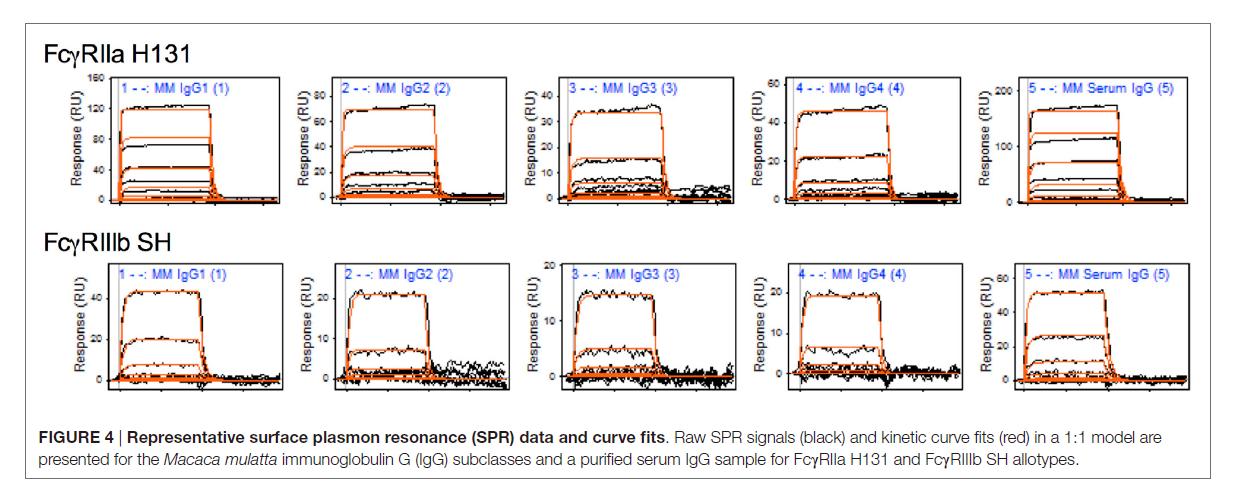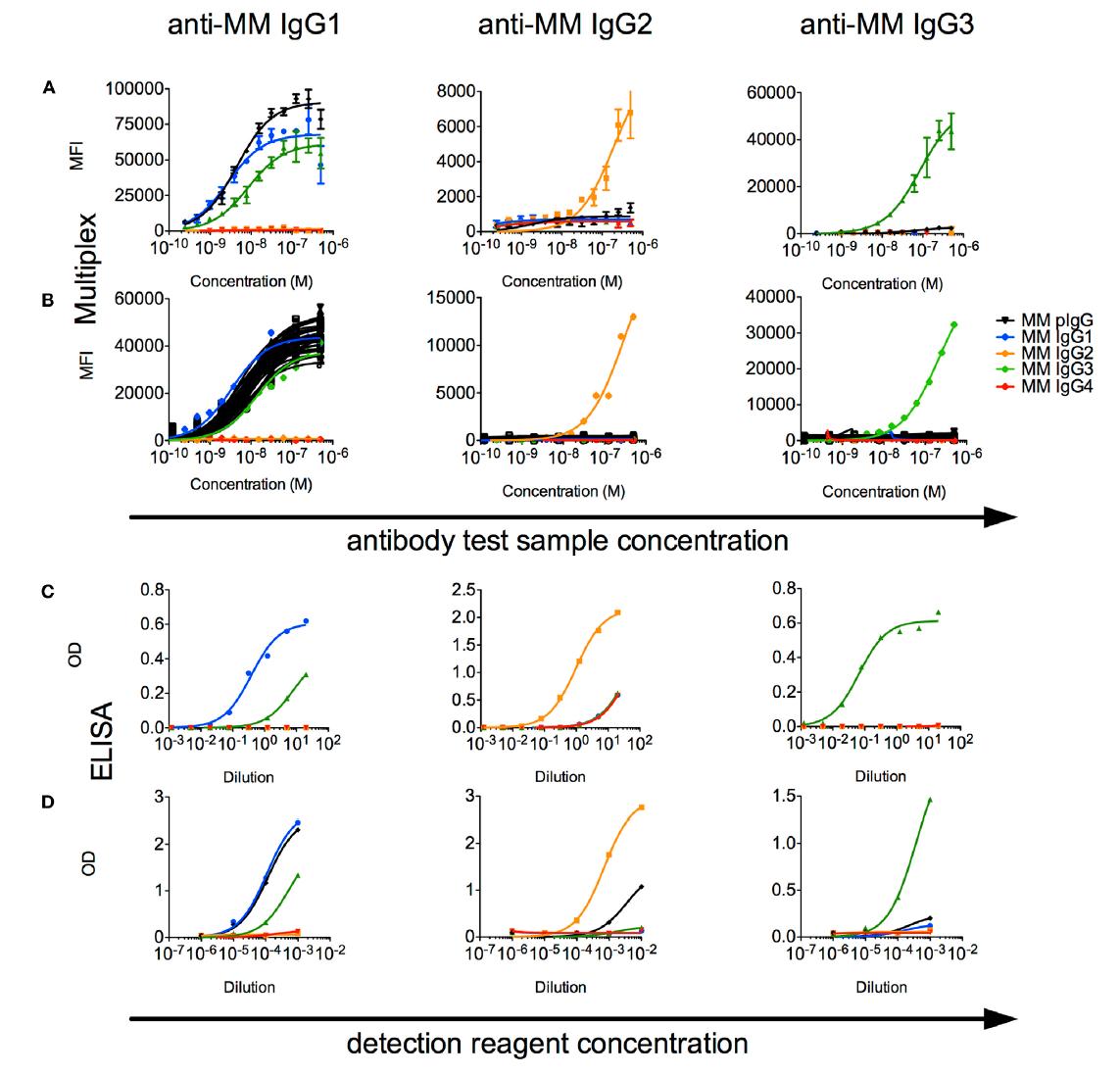- This product is a purified antibody that was generated by immunizing mice against a rhesus immunoglobulin.
Detailed Product Description
- Conjugate: None
- Antibody Isotype: IgG2cκ
- Applications: ELISA
Technical Specifications
- Host Species: Mouse
- Species Reactivity: Rhesus
Product Property
- Purification: Protein A affinity purified
- Format: Liquid
- Concentration: 1 mg/ml
- Buffer: PBS with 0.02% Proclin 300
- Storage: Store at 4⁰C for up to 3 months. For longer storage, aliquot and store at -20⁰C.
Target Information
- Target: IgG1
- Clone: 3C10
This document discusses the biophysical and functional characterization of immunoglobulin G (IgG) subclasses in Indian rhesus macaques (Macaca mulatta, MM), which are crucial in preclinical vaccine studies. The study evaluates the binding of MM IgG1, IgG2, IgG3, and IgG4 to human Fc gamma receptors (FcγR) and their ability to elicit effector functions in human FcγR-bearing cells. Contrasting with human IgGs, the study finds an absence of IgG subclasses with dramatically silent Fc regions in rhesus macaques. Biophysical in vitroand in vivocharacterizations reveal that MM IgG1 exhibited the highest effector function activity, followed by IgG2, then IgG3/4, differing from the human IgG1 and IgG3, which dominate effector function in humans.
The sequence and structural differences among IgG subclasses show that MM IgG types are most similar to human IgG1 among predicted contact residues, suggesting that MM IgG may function similarly to human IgG1 and may not exhibit the broad range of effector activities present in human IgG subclasses.
The study also examines the dependency of MM IgG interaction with FcγRI on IgG glycosylation. It was found that the high-affinity human FcγRI receptor favored MM IgG1 over other subclasses and that glycosylation was crucial for this interaction. Removal of N-linked IgG glycans with PNGase F eliminated FcγRI recognition, and glycan restriction with EndoS, which leaves a core GlcNac, also compromised binding.
Furthermore, the ADCC (antibody-dependent cellular cytotoxicity) potential of MM IgG subclasses was assessed using NK cell degranulation assays. This analysis is significant for understanding how MM IgG subclasses may perform in vaccine and therapeutic contexts, particularly in translating findings from rhesus macaque models to human applications.
 Fig. 1 Representative surface plasmon resonance (SPR) data and curve fits.1 Raw SPR signals (black) and kinetic curve fits (red) in a 1:1 model are presented for the Macaca mulattaimmunoglobulin G (IgG) subclasses and a purified serum IgG sample for FcγRIIa H131 and FcγRIIIb SH allotypes.
Fig. 1 Representative surface plasmon resonance (SPR) data and curve fits.1 Raw SPR signals (black) and kinetic curve fits (red) in a 1:1 model are presented for the Macaca mulattaimmunoglobulin G (IgG) subclasses and a purified serum IgG sample for FcγRIIa H131 and FcγRIIIb SH allotypes.
 Fig. 2 Characterization of rhesus immunoglobulin g (igg) subclass composition and detection reagents.1 (a,B) Multiplex subclassing assays. (a) Recombinant monoclonal rhesus macaque IgG [Macaca mulatta(MM) IgG1–4] and pooled purified polyclonal rhesus macaque plasma IgG (MM pIgG) were titrated for binding to microspheres conjugated with anti-MM, subclass-specific antibodies (anti-MM IgG1, anti-MM IgG2, anti-MM IgG3), and bound test antibody detected by a pan anti-rhesus IgG detection antibody. (B) In a separate experiment, antibody purified from serum samples from 36 naïve MM (black) was likewise evaluated to detect the presence of IgG1, IgG2, and IgG3 subclasses. (c,D). ELISA subclassing assays. (c) Sensitivity and specificity of MM subclass detection reagents over a titration range when recombinant, CD8α-specific MM IgG subclass antibody test samples were bound to CD8α-conjugated ELISA plates. (D) The composition of MM serum IgG in a pooled sample was evaluated viaan ELISA in which either non-specifically adhered serum IgG or recombinant MM IgG subclasses as controls were detected using a dilution series of the anti-subclass detection reagents.
Fig. 2 Characterization of rhesus immunoglobulin g (igg) subclass composition and detection reagents.1 (a,B) Multiplex subclassing assays. (a) Recombinant monoclonal rhesus macaque IgG [Macaca mulatta(MM) IgG1–4] and pooled purified polyclonal rhesus macaque plasma IgG (MM pIgG) were titrated for binding to microspheres conjugated with anti-MM, subclass-specific antibodies (anti-MM IgG1, anti-MM IgG2, anti-MM IgG3), and bound test antibody detected by a pan anti-rhesus IgG detection antibody. (B) In a separate experiment, antibody purified from serum samples from 36 naïve MM (black) was likewise evaluated to detect the presence of IgG1, IgG2, and IgG3 subclasses. (c,D). ELISA subclassing assays. (c) Sensitivity and specificity of MM subclass detection reagents over a titration range when recombinant, CD8α-specific MM IgG subclass antibody test samples were bound to CD8α-conjugated ELISA plates. (D) The composition of MM serum IgG in a pooled sample was evaluated viaan ELISA in which either non-specifically adhered serum IgG or recombinant MM IgG subclasses as controls were detected using a dilution series of the anti-subclass detection reagents.
Reference
- Austin W. Boesch., et al. " Biophysical and Functional characterization of rhesus Macaque igg subclasses" Frontiers in Pharmacology.(2016). Distributed under Open Access license CC BY 4.0, without modification.
-
Q 1: What is the shelf life of the product?
A: When stored properly, the antibody remains stable for one year from the date of receipt.
-
Consistent and Reproducible
The 3C10 antibody from Creative Biolabs provided consistent and reproducible results in our lab.
Click the button below to contact us or submit your feedback about this product.
This site is protected by reCAPTCHA and the Google Privacy Policy and Terms of Service apply.
Enter your email here to subscribe.
SubmitFollow us on


 Cynomolgus Monkey PBMCs
Cynomolgus Monkey PBMCs